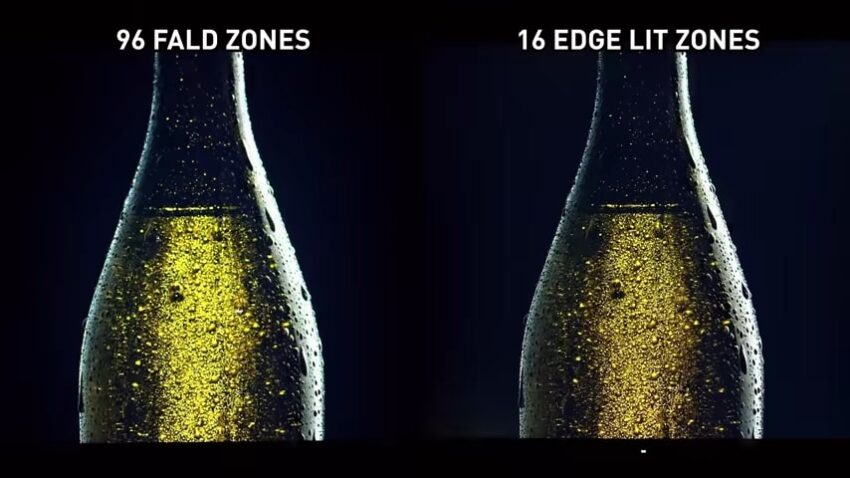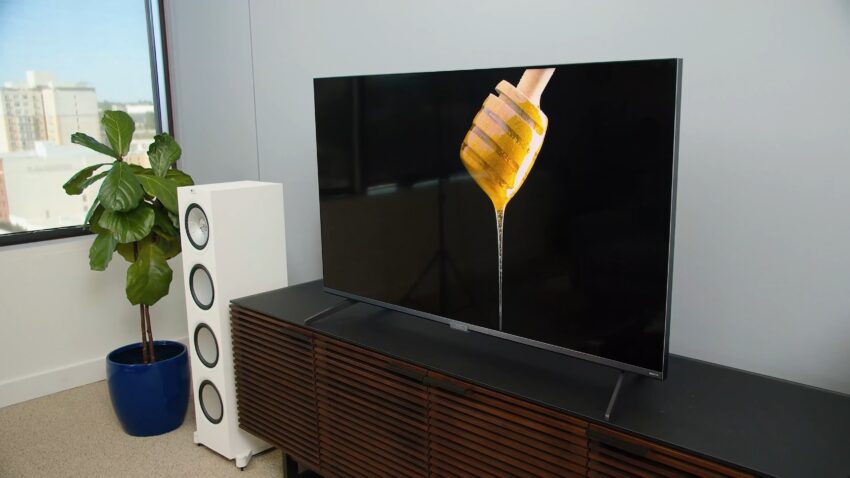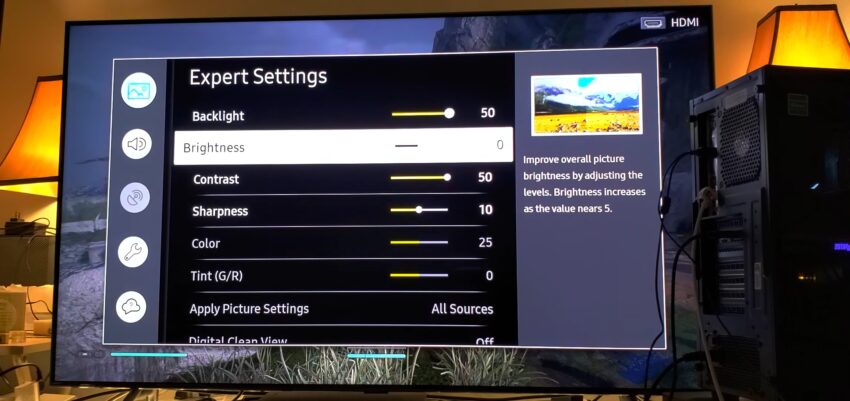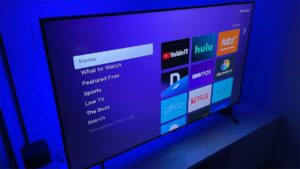Local dimming is a function of L that make the background screen dim when displaying the picture to the user. This cause the black appear deeper and darker on those parts of the screen, which is a great benefit for the peoples who watch the pictures or the videos with darker scenes, like movies, and tv shows.
Local dimming was been introduced to enhance or improve the contrast ratio in led and LCDs. As the LCD industry moved towards the lowest price, cheaper, thinner edge-lit methods, local dimming was adopted to work with these TVs too. To check the local dimming, we play a test video on the LCDs to see whether it’s working effectively. We then evaluate the TVs objectively on the basis of whether the function improves the performance of the picture quality.
When it matters:
local dimming is developed to enhance the contrast ratio by making the black color look more darker and deeper. The local dimming feature will then show the major differences when watching the videos in a darker room. Lights were on in the room would cause the tv to reflect that light, which means you won’t to be to know the feature or the advantages of the local dimming.
How to get the best results:
Some TVs offer inbuild feature as local dimming setting. Low settings will usually dim the backlight less, but the downsides of local dimming (see the section above) also won’t manifest quite as badly. Higher settings dim more, but also more significant downsides.
Local options for dimming are different, so if you have various alternatives, attempt specific settings and choose the one you like best. Apart from that, there is no method to achieve better local dimming results. If this is a feature that matters to you, make sure you get a highly scoring TV in this test.
Types of local dimming:
There are 3 different types of local dimming – edge-lit, back-lit and full-array and you’ll need to consider which is right for you.
Edge-lit local dimming:
Most of the TVs with local dimming are edge-lit. As the title suggests, the LED lights stand around the corners of the display instead of behind it. They need smaller LEDs than designs that are back-lit or full-array – so they’re running thinner and more energy-efficient.
Back-lit local dimming:
Here the LED light is located back or behind the screen. it has also called “global dimming”. Found on lower-priced TVs, the LEDs function as a separate light, making the whole picture darker with darker images and brighter parts.
Full-array local dimming:
The lights are sitting behind the display again, but they’re zoned this time. For the ultimate image quality, certain zones are dimmed and lightened as required. Full-array offers the finest out of 4K HDR (full vibrant spectrum) televisions by providing even higher color contrast.
Why does local dimming exist
For up to 10 years, the contrast between LCD and LED TVs has been top-out at 5000:1, and blacks on LED TVs are at best very dark gray, even now. This is due to the fact that LCD and LED devices are backlit, implying that they rely on a light behind the panel to make the image clear, and the LCD layer can not block any light from leaking from the frame. This combination means black still gets illuminated a bit and so has a brightness. This reduces contrast.
Some LED TVs utilize local dimming in an attempt to mask this shortcoming to avoid dark parts of the panel and dim the backlight in those regions. The intended result is darkened parts, but everything else should stay as vivid as it should be, that the difference between dark and light. However, there is always a trade-off because the backlight is not precise enough. Even the best local dimming introduces issues to the picture, so some people will much prefer to leave local dimming off when it is available.
Benefits of Local Dimming for TV Viewing:
- Improved Contrast Ratio: Local dimming enhances the contrast ratio of the TV by making the blacks look deeper and darker. This makes the picture quality appear more vibrant and realistic.
- Enhanced Picture Quality: With local dimming, the TV can display more accurate colors and finer details. This is particularly beneficial for watching movies and TV shows with darker scenes.
- Reduced Reflections: Local dimming helps to reduce reflections on the TV screen, making it easier to watch TV in brightly lit rooms.
- Energy Efficient: LED TVs with local dimming are more energy-efficient compared to other types of TVs. They consume less power and emit less heat, making them more eco-friendly.
- Better Gaming Experience: TVs with local dimming have low input lag and excellent motion handling, making them a great option for gamers.
- Cost-Effective: TVs with local dimming technology are relatively affordable compared to other high-end TVs, making them accessible to a wider audience.
- Wide Range of Options: Local dimming technology is available in a wide range of TVs, from entry-level models to high-end models, giving consumers plenty of options to choose from.
Local Dimming and HDR: How They Work Together
Local dimming and HDR are two separate features found in modern televisions that work together to provide a better viewing experience.
Local dimming is a feature that dims the backlight in specific areas of the TV screen to enhance the depth and darkness of blacks. This results in better contrast and more vibrant colors. On the other hand, HDR (High Dynamic Range) is a feature that expands the range of colors and brightness levels that a TV can display, resulting in more vivid and realistic images.
When local dimming and HDR are used together, the result is an even more impressive picture quality. Local dimming can help to enhance the contrast between bright and dark areas in HDR content, making the picture more vivid and realistic. This combination can be especially effective for watching movies or TV shows with a lot of dark scenes or bright highlights.
It’s important to note that not all TVs with local dimming are capable of displaying HDR content, and not all HDR TVs have local dimming. Therefore, if you’re looking for a TV that can display both HDR content and has local dimming, it’s essential to check the specifications before making a purchase.
The Future of Local Dimming in TV Technology
Local dimming technology has come a long way since its inception, and it’s set to be a prominent feature in TV technology moving forward. The future of local dimming lies in advanced algorithms and software that can accurately track and adjust individual dimming zones, resulting in better contrast ratios and more natural-looking colors.
One major trend is the increased adoption of full-array local dimming, which is seen as the ultimate solution for local dimming technology. Full-array local dimming uses hundreds of individual dimming zones, making it possible to accurately adjust the backlight to suit each scene.
Another emerging technology is mini-LED, which promises to offer better control over backlighting than traditional LED TVs. Mini-LED uses much smaller LEDs than standard LEDs, which means that there can be more of them, providing more precise control over the backlight.
OLED technology also has an impact on local dimming. OLED TVs can control the brightness of each pixel individually, resulting in near-perfect black levels and excellent contrast ratios. However, OLED technology is currently more expensive than other options, making it less accessible to the general public.
In addition to these advances in technology, local dimming is also expected to play a crucial role in the adoption of High Dynamic Range (HDR) technology. HDR content requires a TV to have a high peak brightness and contrast ratio, which can be achieved through the use of local dimming technology.
Local dimming can introduce minor problems on some TVs
- Light spreading into the darker room around bright objects.
- A trail of light following moving bright objects.
- A loss of detail in dark areas.
- Unintended parts of the dimmed display.
- A fluctuating brightness of the screen.
Related settings:
- Contrast: This setting affects the color contrast of the TV panel, not the effectiveness of the quality of the local dimming.
- Peak brightness: Some TVs also have a setting that makes the white highlights extra bright. It functions similarly to that of local dimming but in reverse. This setting is very important for HDR media.
- Micro dimming: A Samsung feature. Processes a video in order to copy the local dimming. It doesn’t dim the background color, but it changes the contrast ratio of the images. A video purist normally do not like it because it messes with the video setting on TV,
- CE dimming: During darker scenes, it dims the lighting for the entire panel. Some people don’t like it, because sometimes, like during a movie’s finish titles, you can feel the entire display dimming at times. In ‘ Movie ‘ mode, it’s not as good, and the ‘ PC ‘ method comes completely disposed of it.
- Frame dimming: Frame dimming is equivalent to edge-lit local dimming but with even smaller zones. Rather than altering the color for a particular display region, it is the lighting of the entire display area that influences the strength. You can see this as a very fundamental local dimming variant.
- HDR: a TV with a good local dimming implementation will do well with HDR because it will be able to further brighten the highlights. Learn more about HDR.
Conclusion:
Local dimming is a feature that dims the backlight color of TVs in order to enhance more darker of blacks. It is very beneficial for the people who like to watch the movies or the videos in the black background to look deeper and darker.
Related Posts:
- Ultimate Guide to Get Better Viewing Angle Explained…
- TV Motion Rate Explained - Your Guide to Smooth Viewing
- 12 Best 75 Inch 4k Smart TVs 2024 - Ultimate Viewing…
- 10 Best Ultra UHD 4K Laptop 2024 - Get the Ultimate…
- LG BX OLED TV Review 2024- Experience the Ultimate…
- 24p Playback Explained - 2024 Guide for Film Enthusiasts











